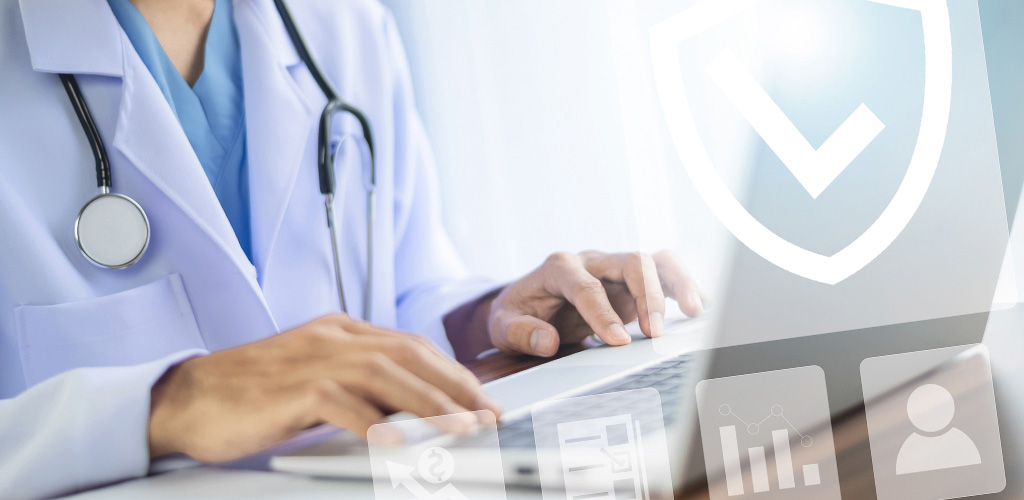The 2020 health crisis has affected each industry, healthcare in particular. Healthcare organizations worldwide have experienced unprecedented strain due to the increasing number of COVID-19 cases, leading to overwhelmed intensive care units, resource allocation challenges, increased workload of medical professionals, and an increased impact on Non-COVID-19 services. In fact, the list of problems can be continued indefinitely, but one of the most critical ones has not been mentioned yet. Healthcare personnel did not have enough hard skills to deal with such an obscure scenario, nor did they receive sufficient soft skills training. This, along with all the other factors, unfortunately, or rather fortunately, has motivated the spread of telehealth and eLearning for healthcare professionals, although it had been gaining momentum before. Indeed, the global EdTech market was valued at $76.4 billion in 2019, owing primarily to the development of smart gadgets and seamless internet connectivity.
Long story short, this article will provide an overview of the changing learning management system, specifically the importance of introducing eLearning programs into medical training. It will provide evidence proving continuing medical education for knowledgeable and resilient healthcare providers is no longer possible without digital learning.
The Need for Innovation in Healthcare Education
Challenges faced by traditional healthcare education methods
In the healthcare industry, much like in any other field, the recognition of the need for change is often prompted by challenging circumstances. A significant challenge faced by students aspiring to dedicate their careers to patient care is the issue of slow update cycles. Information contained in textbooks and other traditional learning resources requires frequent revision and additions, creating a potential lag in the dissemination of current and crucial information. This delay can significantly impact patient care, particularly under extreme conditions, highlighting the imperative for more dynamic and responsive educational approaches. Now, let's move on to the actual evidence. According to this study, printed learning materials only slightly improve healthcare training compared to no intervention. Another study that focused on the advancements of eLearning in undergraduate clinical medicine provides us with more detailed results. The 42 studies differed in terms of breadth, cognitive domain, subject matter, design, quality, and evaluation. The most popular ways were eLearning platforms (33%) and case-based learning (26%), which were interactive (83%), asynchronous (71%), and accessible from home (83%). Twelve studies (29%) assessed usability, and all reported positive results. Successful students and preceptors shared crucial traits such as technological competence, high enthusiasm, and an open mindset.

Another common challenge faced by traditional medical education is the lack of interactivity. Evidently, learning environments need to be built so that future medical professionals have plenty of access to hands-on experiences that are invaluable in patient care. This study proves — eLearning tools are crucial in increasing learner engagement and involvement in lectures and other group learning activities. Traditional training methods are also deficient when allowing students to simulate real-world challenges. For example, in conventional learning environments, healthcare professionals might not experience realistic simulations of high-pressure scenarios, such as emergency surgeries or critical patient interventions. This lack of exposure may limit their ability to handle the complexities of dynamic healthcare settings, impacting their readiness to navigate real-world challenges with precision and confidence.
The extensive array of challenges encompasses various aspects, some of which have not been explicitly addressed. However, the length of the list does not diminish the importance of these issues. In brief, traditional medical education stands in need of enhancements, particularly through the integration of modern technologies. These advancements are anticipated to play a pivotal role in addressing the multifaceted challenges faced by the current healthcare education system:
- Limited interactivity and difficulty in simulating real-world scenarios
- Slow update cycles
- Inflexible learning schedules
- Resource constraints
- Underemphasis on technology integration and so on.
Demands of a rapidly evolving healthcare landscape
Just like any other industry, healthcare is moving forward, meaning the healthcare workforce needs to dedicate themselves to a lifelong learning revolution, utilizing modern learning solutions, like eLearning courses, compliance training, and so on. As of 2024, here are the top most urgent demands of the healthcare industry:
1. Advanced Telehealth Infrastructure
The rapid expansion of telehealth services has become a cornerstone of healthcare delivery. The demand for robust and advanced telehealth infrastructure is paramount, fueled by the need for accessible and convenient healthcare services. In 2024, healthcare organizations will be compelled to invest in cutting-edge telehealth technologies to ensure seamless virtual consultations, remote monitoring, and efficient communication between healthcare professionals and patients. The ability to deliver high-quality care beyond traditional healthcare settings is not only a convenience but also a necessity, addressing the demand for accessible healthcare services, particularly in remote or underserved areas.
2. Cybersecurity Measures
The healthcare industry's increasing reliance on electronic health records and eLearning courses has escalated the urgency for robust cybersecurity measures. Protecting sensitive patient data from cyber threats is a non-negotiable priority. With the growing sophistication of cyberattacks, healthcare organizations in 2024 must invest in state-of-the-art cybersecurity solutions, employee training, and comprehensive risk management strategies. The safeguarding of patient information is crucial not only for compliance with regulatory standards but also for maintaining trust and ensuring the integrity of healthcare services.
3. Integration of Artificial Intelligence (AI) and Machine Learning (ML)
AI and ML technologies are ushering in a new era in healthcare, offering unprecedented opportunities for diagnostics, treatment planning, and operational efficiency. The urgent demand for healthcare organizations is to integrate these advanced technologies into their workflows. From predictive analytics for disease management to personalized treatment plans, AI and ML are instrumental in enhancing clinical decision-making and optimizing resource allocation. The industry's urgent call is for healthcare professionals to embrace and leverage these technologies to improve patient outcomes, streamline processes, and stay at the forefront of medical advancements.
4. Strengthened Mental Health Services
The global recognition of the importance of mental health has intensified the demand for strengthened mental health services within the healthcare industry. In 2024, healthcare organizations are under increasing pressure to enhance their mental health offerings, including accessible counseling services, telepsychiatry, and community-based support programs. Addressing mental health concerns has become a moral imperative and a strategic necessity to ensure holistic patient care and overall well-being.
Read also: Mental Health App Development: Your Perfect Guide for 2023
5. Enhanced Interoperability
The seamless exchange of patient information across healthcare systems remains a critical demand for the industry. Achieving enhanced interoperability and providing decent compliance training is crucial for providing comprehensive and coordinated care. In 2024, healthcare organizations are urged to adopt interoperable systems that facilitate the secure sharing of patient data among different healthcare providers. This demand is fueled by the imperative to reduce redundancy, improve care coordination, and empower patients to actively participate in their healthcare journey.
Introduction to the role of eLearning in addressing these challenges
Since 2000, the eLearning sector has risen by 900 percent. And it is predicted to quadruple by 2025. Over the last five years, the number of enrolled learners on Coursera, one of the most popular online learning platforms, has surged by 438%. Coursera's enrolled learners have already topped 136 million. Furthermore, industry content is driving the fight to drive Coursera's consumer revenue growth, with Google's content alone expected to generate $100 million in revenue for the firm.

E-learning stands as a direct outcome of the pervasive influence of digitization across various industries. Unlike the traditional approach, where daily attendance at a university and carrying hefty printed materials were the norm, today's learners can reap equivalent, if not superior, benefits from the comfort of their own homes. The abundance of programs and resources, featuring online courses and literature, ensures students access to the most current knowledge. This is in stark contrast to printed materials, as online resources undergo regular updates and thorough checks for relevance.
When it comes to healthcare, the impact of contemporary training methods on shaping the future of medical professionals is monumental. While complete remote training for aspiring doctors is not currently feasible due to the essential need for hands-on patient experience, ongoing technological advancements actively address this limitation. The intrinsic value that technology introduces to the education of future healthcare practitioners is immeasurable, fostering a dynamic and progressive learning environment that prepares them for effective decision-making in their forthcoming careers.
Pioneered by platforms like Touch Surgery, adaptive eLearning tailors content to individual learners' needs, elevating the learning experience's personalization and efficiency. Studies underscore a noteworthy surge in knowledge retention and learner engagement when educational content aligns with individual preferences.
In the realm of flexibility, virtual classrooms and asynchronous modules within contemporary eLearning empower healthcare professionals to navigate educational materials at their own pace, catering to demanding work schedules. Cutting-edge applications, like Osso VR for surgical training, immerse healthcare professionals in risk-free environments, allowing the practice of intricate procedures. Research findings highlight a significant 45% enhancement in surgical skill acquisition through Virtual Reality (VR) simulations, surpassing traditional training methods.
Facilitating global knowledge exchange, online forums, and training courses enable healthcare professionals to share insights, discuss cases, and engage in interdisciplinary discussions. A recent study noted a commendable 25% rise in cross-disciplinary collaboration among healthcare professionals involved in international eLearning communities.
Learning Management Systems (LMS) with real-time analytics empower educators to monitor learners' progress and identify areas for improvement promptly. Healthcare providers embracing eLearning report a substantial 20% increase in the efficiency of addressing students' learning needs through data-driven insights.
Advantages of Online Learning in Healthcare Education
eLearning has revolutionized healthcare training, offering a myriad of advantages that cater to the evolving needs of learners and institutions. From enhanced flexibility to real-time progress tracking, the benefits of online learning in the healthcare sector are profound and far-reaching.

Flexibility and accessibility for learners
Online learning in healthcare brings unparalleled flexibility and accessibility to learners, transcending geographical constraints and time limitations. For instance, platforms like the previously mentioned Coursera and edX offer a plethora of digital courses from top universities worldwide, allowing healthcare professionals to access high-quality education without the need for face-to-face learning. This flexibility is particularly crucial for practitioners seeking continuous learning while managing demanding work schedules or for students pursuing degrees in healthcare from remote locations.
Moreover, synchronous and asynchronous learning options cater to different learning preferences. Live virtual classes, video lectures, and interactive modules provide diverse ways for healthcare learners to engage with educational content, accommodating various learning needs and boosting student engagement.
Customization of learning experiences
eLearning programs enable the customization of educational experiences, tailoring content to individual learner needs. Adaptive learning technologies, such as those employed by platforms like Khan Academy or Osmosis, use algorithms to assess learners' strengths and weaknesses, delivering personalized content, and practice exercises. This method of eLearning offers targeted training, addressing specific gaps in students' knowledge and skills, and motivating future practitioners to achieve their learning goals.
Simulation technologies further enhance customization by providing realistic scenarios that align with learners' specific areas of focus. For example, projects like Touch Surgery Enterprise Edition simulate surgical procedures, allowing learners to practice and refine skills in their specialized medical field.
Cost-effectiveness and scalability
Online learning brings about cost-effective solutions for both learners and institutions in the healthcare sector. Traditional face-to-face learning often incurs expenses related to travel, accommodation, and physical materials. In contrast, online education eliminates these overhead costs, making learning more affordable and accessible.
The scalability of online education is evident in the Massive Open Online Courses (MOOCs) offered by Coursera, where thousands of learners can enroll simultaneously. This scalability ensures that healthcare education can reach a global audience, motivating students' knowledge sharing and collaboration among professionals from diverse backgrounds.
Many organizations can also benefit from cost-effective online learning solutions. Developing and maintaining an online course is often more affordable than a traditional classroom setup. This cost-effectiveness allows institutions to allocate resources strategically, investing in medical technology, guest lectures, or additional eLearning software.
Real-time tracking of progress and performance
One of the distinctive benefits of eLearning in healthcare is the ability to track learners' progress and performance in real-time. Learning Management Systems (LMS) like Blackboard or Canvas provide comprehensive analytics and reporting tools that enable educators to monitor learners' engagement, assess performance on assessments, and identify areas that may require additional support.
For example, Osso VR, a surgical web-based learning platform, incorporates real-time performance metrics, allowing both learners and educators to track proficiency in surgical techniques. This immediate feedback loop facilitates targeted interventions, ensuring that learners receive timely guidance and support.
Moreover, real-time tracking enhances the accountability of learners, promoting a proactive approach to their education. By monitoring progress continuously, healthcare professionals can set goals, track achievements, and adjust their learning strategies accordingly, fostering a self-directed and motivated learning experience.
Overall, the benefits of eLearning in healthcare education are multifaceted and impactful. In short, here are the primary benefits that make the modern healthcare industry truly different:
- flexible access to education
- the ability to customize learning experiences
- cost-effective solutions
- real-time progress tracking, and a lot more
eLearning has become an indispensable tool for shaping the future of healthcare education. The examples mentioned illustrate the diverse applications of online education technologies, showcasing their potential to elevate the knowledge and skills of healthcare professionals worldwide.
Cutting-edge Technologies Shaping eLearning in Healthcare
Virtual Reality (VR) and Augmented Reality (AR) applications
Virtual Reality (VR) technology has revolutionized medical education, providing immersive and practical experiences for students across various domains. In surgical training, platforms like Touch Surgery and Osso VR offer realistic simulations, enabling students to practice intricate procedures in a risk-free virtual environment. This hands-on experience not only enhances their surgical skills and treatment methods, but also builds confidence and decision-making abilities before entering the operating room.

VR applications extend to anatomy education through platforms like Complete Anatomy. Students can explore the human body in three-dimensional spaces, dissect virtual cadavers, and visualize anatomical structures in ways traditional textbooks cannot match. This immersive approach fosters a deeper understanding of anatomy and spatial relationships. Moreover, VR is employed to simulate patient scenarios, promoting empathetic communication skills. Applications like Embodied Labs allow students to experience the physical and emotional aspects of various medical conditions, cultivating empathy and a holistic approach to patient care. Additionally, medical simulations in VR create dynamic training environments where students can practice responding to emergencies, refining diagnostic skills, and making critical decisions under pressure.
Augmented Reality (AR) seamlessly integrates virtual elements into the real world, offering unique learning experiences for medical students. In anatomy education, AR applications like Microsoft's HoloLens allow students to overlay 3D anatomical models onto physical objects, offering an interactive and spatial understanding of anatomy. AR is also applied in medical imaging education, where students can use AR devices to visualize and interpret complex medical images in three-dimensional space. This hands-on approach enhances proficiency in image analysis and diagnostics, providing practical skills for future medical practice.
Another significant application is in virtual patient consultations, where AR facilitates the overlay of medical information onto a patient's physical anatomy during an examination. This real-time augmentation enhances communication between medical professionals and patients, improving the explanation of medical conditions, treatment options, and potential outcomes.
Furthermore, AR fosters remote collaborative learning experiences. Students equipped with AR devices can share holographic images, collaborate on medical cases, and engage in teamwork, even in remote settings. This collaborative aspect enhances communication skills and prepares students for the teamwork required in healthcare practice.
The integration of VR and AR technologies in medical education goes beyond traditional approaches, offering immersive, practical, and collaborative learning experiences. As medical students engage with these technologies, they not only gain theoretical knowledge but also close the practical skills gap, ultimately preparing them for the complexities of real-world healthcare scenarios.
Artificial Intelligence (AI) in personalized learning and simulations
Artificial Intelligence (AI) has ushered in a new era of personalized learning and simulations in healthcare eLearning, revolutionizing how future healthcare employees acquire and apply knowledge. In the realm of personalized learning, AI algorithms analyze individual student performance, preferences, and learning styles to tailor educational content. Platforms like Osmosis utilize AI to create customized learning paths, ensuring that each student progresses at their own pace, thereby enhancing understanding and retention, and the overall eLearning experience.
AI-driven simulations offer students immersive experiences to apply theoretical knowledge in realistic scenarios. For instance, InsightHeart employs AI to simulate intricate cardiac procedures, allowing students to navigate virtual surgeries and refine their skills in a risk-free environment. This hands-on approach transcends traditional learning solutions, providing a dynamic platform for students to make clinical decisions, hone their procedural techniques, and gain practical experience.

The knowledge acquired through AI-driven personalized learning and simulations equips future healthcare staff members with skills applicable to diverse real-life scenarios. Whether faced with complex patient cases, emergencies, or intricate medical procedures, students can leverage their AI-enhanced education to make informed decisions and exhibit clinical competence. This personalized, adaptive, and clinically relevant approach positions AI as a cornerstone in shaping the capabilities of future healthcare workers.
Gamification for enhanced engagement and retention
Gamification proves to be a transformative strategy for engaging and educating future healthcare workers, blending the allure of gaming elements with the rigor of medical education. In this context, gamification aims to make product training not only informative but also enjoyable, fostering a sense of competition, achievement, and sustained motivation among students pursuing healthcare professions.
Anatomy education receives a significant boost through gamification as well. Platforms like Touch Surgery Enterprise Edition employ gamified elements in virtual dissection experiences. Here, healthcare staff can interactively explore anatomical structures and tackle challenges, turning the traditionally daunting task of memorizing anatomy into an engaging and dynamic learning adventure. This approach both reinforces knowledge retention and helps students develop spatial awareness and procedural memory, vital for their future roles in the healthcare industry.
In the realm of medical simulations, gamification is seamlessly integrated to provide students with a competitive edge. Osso VR, for instance, introduces gamified elements into surgical simulations, allowing students to track their progress, compete with peers, and receive instant feedback. This gamified feedback loop not only motivates students to strive for excellence but also fosters continuous improvement and product training, making the learning environment more dynamic and goal-oriented.
The impact of gamification extends beyond the classroom. Healthcare students equipped with gamified learning experiences are better prepared for real-world challenges. They can apply their acquired knowledge and skills with confidence in complex patient cases, emergency situations, and medical procedures. Ultimately, gamification in healthcare education transforms the learning journey into an enjoyable adventure, providing future healthcare workers with not just theoretical knowledge but also practical and resilient skills crucial for their future careers.

Addressing Challenges and Concerns in eLearning for Healthcare
The integration of eLearning in healthcare education is not without its challenges and concerns. As the sector transitions towards digital platforms, overcoming resistance to change, ensuring privacy and security, and bridging the digital divide emerge as critical considerations.
Overcoming resistance to change
Resistance to change is a common hurdle in most organizations worldwide, especially in healthcare education, where only traditional instructional design methods have long been accepted. Faculty, administrators, and even some students may be apprehensive about adopting eLearning in healthcare methodologies. One possible strategy is to emphasize the tangible benefits of eLearning programs, such as increased accessibility, flexible learning schedules for most online courses, and interactive engagement.
For example, the Cleveland Clinic, a renowned healthcare institution, successfully implemented eLearning training process by involving faculty members in the design and implementation procedures. Faculty were given training and support to transition smoothly into the digital landscape. This participatory approach not only eased learning for healthcare but also empowered educators to contribute to the evolution of the curriculum.
Moreover, showcasing success stories and outcomes from eLearning implementations in other healthcare institutions can serve as powerful motivators. Demonstrating improved learning outcomes, increased student engagement, and the seamless integration of eLearning tools can sway skeptics towards recognizing the positive impact of change that fosters best practices in healthcare.
Ensuring privacy and security in eLearning platforms
The sensitive nature of healthcare data necessitates stringent measures to ensure privacy and security in eLearning courses and platforms. Compliance with regulatory frameworks, such as the Health Insurance Portability and Accountability Act (HIPAA) in the United States, is imperative to safeguard patient information.

For example, Osso VR prioritizes privacy and security by employing encryption protocols and adhering to industry-specific regulations. By implementing secure authentication processes and encrypted data transmission, they provide a safe environment for healthcare professionals to engage in virtual surgical simulations and access course content without compromising patient confidentiality.
In addition to technical safeguards, user education on privacy practices becomes paramount. Institutions can implement training modules that educate healthcare professionals about the secure use of eLearning courses, emphasizing the importance of adhering to privacy policies and maintaining the confidentiality of patient data.
Regular audits and assessments of eLearning platforms for vulnerabilities are essential components of a robust security strategy. By conducting thorough security assessments, healthcare institutions can identify and address potential risks, ensuring a safe and secure environment for eLearning.
Strategies to bridge the digital divide in healthcare education
The digital divide, characterized by disparities in access to technology, is a significant concern in healthcare education. To bridge this gap, strategies must be implemented to ensure that all healthcare professionals, regardless of their geographical location or socioeconomic background, have equal access to eLearning opportunities.
Project ECHO (Extension for Community Healthcare Outcomes), an innovative telemedicine initiative, exemplifies a strategy to bridge the digital divide. It connects healthcare professionals in underserved areas with specialists through virtual case-based learning sessions. This approach not only leverages learning but also addresses geographical disparities by providing real-time access to expert knowledge, fostering a collaborative learning environment.
To address infrastructural challenges, partnerships with government agencies, non-profit organizations, and technology providers can facilitate the establishment of digital infrastructure in underserved regions. Initiatives providing subsidized or low-cost medical equipment and internet connectivity can further democratize access to learning resources, as medical professionals can simply access their course content via mobile devices.

Moreover, designing eLearning platforms with user-friendly interfaces and considering the varied technological literacy levels of healthcare professionals is also super important. Customizing course content to accommodate low-bandwidth environments and providing offline access options can ensure that learners with limited resources can still benefit from eLearning initiatives.
Future Trends in eLearning for Healthcare
The evolution of eLearning in healthcare is set to embrace transformative trends that not only enhance individual learning experiences but also foster collaborative knowledge-sharing and leverage emerging technologies. As we peer into the future, key trends like predictive analytics and collaborative learning truly stand out.
Predictive analytics and adaptive learning
Predictive analytics is revolutionizing healthcare education by leveraging data-driven insights to anticipate learners' needs and optimize their educational journey. By employing sophisticated algorithms, eLearning platforms can analyze historical data, learner performance, and engagement patterns to make accurate predictions about future progress. This enables a proactive approach to addressing challenges faced by individual learners and optimizing learning management systems.
IBM Watson Education is at the forefront of incorporating predictive analytics in healthcare education. By analyzing learner data, it can predict when students are likely to struggle with specific topics and provide targeted interventions. For instance, if a nursing student consistently faces challenges in compliance training, the platform can recommend additional resources, adaptive modules, or personalized assessments to enhance comprehension.
Adaptive learning, on the other hand, tailors the educational experience in real-time based on individual learner performance. This approach ensures that healthcare professionals receive personalized content, adapting to their pace of learning and helping to close their skills gap.
Area9 Lyceum's Rhapsode is an adaptive learning platform used in healthcare eLearning. It continuously assesses learners' proficiency, adjusting the difficulty and content of the material accordingly. If a healthcare professional demonstrates mastery in a certain area, the platform dynamically shifts focus to more challenging topics, optimizing the learning journey.
Collaborative learning and virtual communities
The future of eLearning in healthcare is characterized by a shift towards collaborative learning and the creation of virtual communities. Recognizing that healthcare is inherently collaborative, eLearning platforms are integrating features that facilitate interaction, discussion, and shared learning experiences among professionals.
Figure 1, a medical case-sharing app, exemplifies collaborative learning. Healthcare professionals globally use the platform to share images and insights from challenging patient cases. This virtual community enables practitioners to engage in discussions, seek advice, and collectively enhance their diagnostic and decision-making skills. Why is this exciting? Because it's within the conversation that the truth comes to light.
Moreover, virtual communities within eLearning platforms create spaces for healthcare professionals to connect, share experiences, and collaborate on research projects. These communities foster a sense of camaraderie and facilitate a continuous exchange of knowledge, ensuring that learners are not isolated but rather part of a global network of healthcare professionals.
Harnessing the Power of Simulation-Based Learning
Simulation-based learning is at the forefront of transforming healthcare education, offering a dynamic and experiential approach for professionals. Advanced technologies like VR and AR amplify the impact of realistic scenarios, enabling healthcare practitioners to immerse themselves in lifelike situations.
In emergency medicine, platforms like Prehos offer simulations for paramedics and emergency responders. These simulations recreate high-pressure situations, allowing professionals to make critical decisions, manage emergencies, and enhance their crisis response skills.
Simulation-based learning extends to patient care interactions. Simulated Patient Programs in medical education involve actors portraying patients, providing healthcare professionals the opportunity to practice communication, empathy, and bedside manner in a controlled yet realistic environment.
The Impact of eLearning on Patient Care
Improving patient outcomes through well-trained healthcare teams
The collaborative nature of healthcare demands well-coordinated and proficient teams. eLearning fosters a culture of continuous learning among healthcare professionals, contributing to the overall competence of interdisciplinary teams. This synergy leads to improved patient outcomes and enhanced quality of care.

For example, TeamSTEPPS (Team Strategies and Tools to Enhance Performance and Patient Safety), an evidence-based teamwork system, employs eLearning modules to train healthcare teams in effective communication and collaboration. By enhancing team dynamics and addressing communication challenges, healthcare professionals can collectively provide safer and more efficient care, positively impacting patient outcomes.
Simulation-based training, facilitated by eLearning platforms, allows healthcare teams to practice and refine their skills collectively. Platforms like InSitum Health offer virtual scenarios for team-based simulations, preparing professionals for real-world challenges and promoting cohesive and efficient teamwork. This results in healthcare teams that are better equipped to respond to complex patient cases, reducing medical errors and enhancing overall patient care quality.
Patient education and engagement through eLearning tools
Beyond healthcare professionals, eLearning also plays a crucial role in patient education and engagement. Informed and engaged patients are more likely to actively participate in their own care, leading to better adherence to treatment plans and improved health outcomes.
Platforms like MyChart enable patients to access their medical records, view test results, and communicate with healthcare providers securely. eLearning tools provide interactive educational materials, explaining medical conditions, treatment options, and preventive measures. Patients can engage in self-paced learning, fostering a deeper understanding of their health and promoting a sense of empowerment in managing their well-being.
Telehealth and eConsult platforms further extend patient education opportunities. PatientPoint, for instance, integrates eLearning components into its patient engagement solutions, delivering targeted educational content to individuals during healthcare visits. As a result, we get enhanced patient understanding and more informed decision-making, contributing to a more collaborative and patient-centered approach to care.

The impact of eLearning on patient care is multifaceted, touching every aspect of the healthcare ecosystem. By empowering professionals with current knowledge, improving teamwork and patient outcomes, and facilitating patient education and engagement, eLearning emerges as a catalyst for positive transformations in the delivery of healthcare services. As technology continues to advance, the potential for eLearning to shape the future of patient care remains both dynamic and promising.
Regulatory and Accreditation Considerations
Accreditation processes for eLearning programs in healthcare are indispensable mechanisms designed to guarantee the efficacy of educational endeavors. Accrediting bodies, such as the Commission on Accreditation of Healthcare Management Education (CAHME) in the United States, rigorously evaluate these programs against established standards. For instance, the CAHME assesses aspects like curriculum quality, faculty qualifications, and the integration of technology in healthcare management eLearning programs. Successful accreditation not only validates the legitimacy of these programs but also assures prospective healthcare workers of their adherence to industry-approved benchmarks. In an era marked by rapid technological advancements, maintaining accreditation standards becomes paramount. This not only instills confidence in digital learning platforms but also ensures that health professionals receive education of the highest caliber, aligning with the dynamic requirements of the ever-evolving healthcare industry.
Conclusion
eLearning for Health Care in 2024 Considerable discourse has highlighted the merits of online education within the medical domain, as well as in various other sectors. The merits of this instructional approach are substantial, ranging from cost-effectiveness for organizations endeavoring to enhance the proficiency of their medical staff to the delivery of higher quality, pertinent, and more efficacious information essential for students in the medical field. Now, maybe one day we will even see the emergence of futuristic campuses, where all the best technology supports healthcare eLearning in the best way possible.
An intriguing statistic further underscores the significance of online learning: a notable 40% of Fortune 500 companies have already integrated eLearning into their training methodologies. Interestingly, students are the ones who opt for this type of education. Data demonstrates that health professions students showed a positive response to e-learning regarding perceptions, acceptance, motivation, and engagement. Doesn't the medical industry necessitate individuals who are not only interested and motivated but also enthusiastic about learning, practicing, healing, and exploring new avenues?





